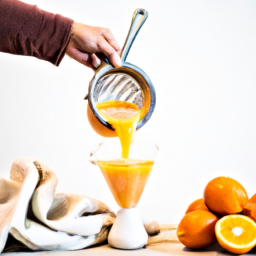Making your own fizzy juice at home provides a pleasant and delicious alternative for enjoying a revitalizing and healthy beverage.
With just a few simple ingredients and equipment, you can create your own unique flavor combinations and control the level of carbonation to your liking.
To make fizzy juice, you will need some basic kitchen tools like a blender or juicer, as well as a carbonation method such as a soda stream or carbonation tablets.
By following a few easy steps, you can enjoy a fizzy drink that is free of added sugars and artificial flavors, and can be customized to your taste preferences.
So, let’s get started on this exciting and tasty adventure of making fizzy juice at home!
Key Takeaways
- Fizzy juice is a healthier alternative to store-bought sodas and can be customized for flavor and carbonation levels.
- Proper storage and serving involve using airtight glass bottles, sterilizing them before filling, and leaving space for carbonation and expansion.
- Homemade fizzy juice can be made using a SodaStream machine or natural carbonation method and can be enhanced with fruits, herbs, and spices.
- Making fizzy juice cost-effectively involves using fresh ingredients, infusing water with fruits and herbs, and buying ingredients in bulk.
What is Fizzy Juice?
Ready to learn about fizzy juice? Let’s dive in and discover what this bubbly drink is all about!
Fizzy juice, also known as carbonated juice, is a type of beverage that is infused with carbon dioxide gas, creating a bubbling sensation and a unique taste. The history of carbonation dates back to ancient times when natural springs containing carbon dioxide were used for their medicinal properties.
Carbonation is known to have some health effects, such as aiding digestion and reducing nausea. However, excessive consumption of carbonated beverages has been linked to health problems like tooth decay and osteoporosis. It’s important to consume carbonated beverages in moderation and be mindful of their effects on the body.
Now that we know what fizzy juice is and its effects on health, let’s move on to the ingredients required to make this delicious drink.
Ingredients Required
So, when it comes to making fizzy juice, there are a few key ingredients you’ll need.
First, you’ll need to choose your juice option – whether that be apple, orange, cranberry, or any other flavor you prefer.
Next, you’ll need carbonated water or soda water to add the fizz.
Finally, you may want to add a sweetener of your choice, such as honey or sugar, though this is optional depending on your personal taste.
Juice Options
First, you’re probably wondering what juices you can use to make fizzy juice – and coincidentally, almost any type of juice will work! You can use single fruit juices like apple, orange, or pineapple, or mix it up with juice combinations like cranberry and grape or mango and passionfruit. The possibilities are endless, so don’t be afraid to get creative with your flavor experimentation.
To make the most out of your fizzy juice, here are a few tips to keep in mind:
- Use fresh and natural juices instead of artificial ones to avoid unwanted chemicals and preservatives.
- Experiment with different ratios of juice and carbonated water to find your preferred level of sweetness and fizziness.
- Add a splash of lemon or lime juice to enhance the taste and balance out the sweetness.
- Remember to stir gently to avoid losing too much of the carbonation.
Now that you know your juice options, let’s move on to the next step: adding carbonated water or soda water to your mix.
Carbonated Water or Soda Water
To elevate the quality of your beverage, you may opt to add carbonated water or soda water to your chosen juice. Carbonated water is simply water that’s been infused with carbon dioxide gas under high pressure, creating a bubbly sensation.
Soda water, on the other hand, has added minerals and sometimes a small amount of sodium bicarbonate for flavor. If you don’t have access to store-bought carbonated or soda water, you can also DIY your own carbonation at home using a soda siphon or a carbonation cap. However, be sure to follow the instructions carefully to avoid any accidents.
Once you have your carbonated or soda water ready, simply mix it in with your juice to give it a fizzy kick. To further enhance the flavor of your fizzy juice, you can add a sweetener (optional).
Sweetener (Optional)
Like a bee drawn to nectar, I understand the desire to add a touch of sweetness to your fizzy drink. Adding sweetener is entirely optional, and there are various options to choose from, including sugar, honey, agave, or even artificial sweeteners. Depending on your preferences, you can add a small amount to enhance the flavor without making it too sugary.
When it comes to flavor options, you can get creative with your sweeteners. For example, you can add a dash of vanilla extract or a squeeze of fresh lemon juice to add a unique taste to your fizzy drink. It’s all about experimenting and finding the perfect balance of sweetness and flavor.
Moving on to the equipment needed, you’ll need a few things to make your fizzy juice a success.
Equipment Needed
One essential piece of equipment needed for making fizzy juice is a carbonation machine. This machine allows you to create your own carbonated water, which can then be added to your juice mixture. Carbonation machines come in various sizes and styles, but they all work in a similar way by adding carbon dioxide to water.
There are also budget-friendly options available for those who don’t want to spend too much money on this essential tool. Another important piece of equipment needed for making fizzy juice is a juicer. This machine allows you to extract juice from fruits and vegetables, which can then be mixed with your carbonated water.
When choosing a juicer, look for one that is easy to use and clean, and that can handle a variety of fruits and vegetables. With these essential tools, you can start preparing your fizzy juice and enjoy a refreshing and healthy drink.
Preparation Steps
Alright, now that we’ve got our equipment ready, it’s time to prepare our fizzy juice.
The first step is to mix the juice and carbonated water in a ratio of your choosing.
Then, if desired, you can add a sweetener to taste.
Finally, fill your bottles and seal them tightly to keep the carbonation intact.
Mixing Juice and Carbonated Water
To mix your juice and carbonated water, start by pouring the juice into a glass. Then, slowly pour the carbonated water on top while stirring gently to ensure the fizziness is evenly distributed. When choosing your flavor combinations, consider the acidity of the juice and how it will react with the carbonation.
Tart juices like lemon or lime will result in a stronger fizz, while sweeter juices like apple or grape will produce a milder carbonation. To achieve the perfect carbonation technique, make sure your carbonated water is chilled before adding it to the juice. This will ensure that the carbon dioxide in the water is more readily absorbed by the juice.
Additionally, avoid shaking the carbonated water vigorously as this can cause it to lose some of its fizziness. Instead, gently stir the mixture while adding the carbonated water. Once your juice and carbonated water are mixed, you can move on to adding sweetener (optional).
Adding Sweetener (Optional)
If you have a sweet tooth, feel free to add sweetener to your juice and carbonated water mixture. There are a variety of sweetener alternatives to choose from, such as agave nectar, stevia, or even fruit juices. Keep in mind that adding too much sweetener can overpower the natural flavors of the juice and make the drink too sugary. It’s important to adjust sweetness levels to your liking by starting with a small amount and gradually increasing until it reaches your desired taste.
Once you’ve added sweetener to your fizzy juice, it’s time to fill your bottles and seal them tightly. Remember to leave some space at the top of the bottle to allow for carbonation and expansion.
In the next section, we’ll go over the final steps to ensure that your fizzy juice stays carbonated and delicious.
Filling Bottles and Sealing
After adding sweetener to the juice, it’s time to fill your bottles and get them ready for carbonation. Before filling the bottles, it’s essential to sterilize them properly to avoid any contamination that may affect the taste of your fizzy juice. You can sterilize the bottles by boiling them in water for ten minutes or using a sterilizing solution.
Once the bottles are sterilized and dried, you can fill them up with the juice, leaving about an inch of space at the top of the bottle to allow for carbonation. After filling the bottles, it’s crucial to seal them tightly to prevent any carbon dioxide from escaping. You can use a bottle capper or a cap that comes with a rubber seal to ensure a tight fit.
Now that your bottles are filled and sealed, it’s time to move on to the next step: carbonation options.
-
Check carbonation levels: Before proceeding with carbonation, it’s crucial to check the carbonation levels of the juice. If the juice is too sweet, it may not carbonate well, and if it’s too acidic, it may carbonate too quickly.
-
Natural carbonation: One way to carbonate your juice is to let it sit at room temperature for a few days. The natural yeast in the juice will convert the sugar into carbon dioxide, creating natural carbonation.
-
Force carbonation: Another option is to force carbonate the juice using a carbonation machine or a soda siphon. This method involves injecting carbon dioxide into the juice under pressure, creating carbonation quickly.
-
Adjust carbonation levels: Finally, it’s essential to adjust the carbonation levels according to your taste preferences. If the juice is too fizzy, you can release some of the carbon dioxide by opening the bottle cap slightly. If it’s not fizzy enough, you can add more carbon dioxide using a carbonation machine or soda siphon.
Now that you know the different carbonation options, it’s time to choose the method that works best for you and enjoy your homemade fizzy juice!
Carbonation Options
When it comes to carbonating my homemade fizzy juice, I have two main options: using a SodaStream machine or using the natural carbonation method.
Personally, I prefer the convenience and consistency of the SodaStream machine. It allows me to easily control the level of carbonation in my drinks and ensures that every batch is fizzy and refreshing.
However, for those who prefer a more hands-on approach, the natural carbonation method can be a fun and rewarding option to try.
Using a SodaStream Machine
To use your SodaStream machine, simply fill the bottle with your favorite juice, attach it to the machine, and press the button to carbonate it. The SodaStream machine provides a more convenient and efficient way to carbonate juice compared to other carbonation methods. It also allows you to control the level of carbonation you want, from lightly sparkling to heavily fizzy.
However, maintaining and cleaning your SodaStream machine is crucial to ensure its longevity and optimal performance. Here are three tips to keep your SodaStream machine in top shape:
-
Regularly clean the carbonating bottle and the machine’s nozzle with warm water and mild soap to prevent clogging and buildup.
-
Replace the carbonating bottle after every two years of use or when it shows signs of wear and tear to maintain the quality of your fizzy juice.
-
Store the carbonator in a cool and dry place, away from direct sunlight, to prevent any damage or leakage.
Now that you know how to use and maintain your SodaStream machine, let’s explore another option for carbonating your juice – the natural carbonation method.
Natural Carbonation Method
Did you know there’s a natural way to carbonate your favorite beverages without using a machine? It’s true! There are several DIY carbonation techniques that can be used to achieve a fizzy drink.
The most common method involves the use of yeast. Yeast is a natural carbonation agent that converts sugar into carbon dioxide, which creates the bubbles in your drink. To use this method, simply mix your desired juice or other beverage with sugar and a small amount of yeast, then let it sit in a sealed container for several hours. The longer you let it sit, the more carbonated it will become.
It’s important to note that natural carbonation is different from artificial carbonation, which is what you get with a SodaStream or other carbonating machine. Artificial carbonation involves adding carbon dioxide gas to your drink, while natural carbonation relies on the natural process of fermentation to create the bubbles.
While both methods can be effective, many people prefer natural carbonation because it’s a more traditional and authentic way to make fizzy drinks.
Now that you know how to naturally carbonate your drinks, let’s move on to the next step: storing and serving your fizzy juice.
Storing and Serving
After refrigerating the fizzy juice, it’s time to pour it into glasses and watch the bubbles dance on the surface. To make the presentation more appealing, I recommend using colorful straws and garnishes like slices of fruit or herbs.
Here are three tips to keep in mind when storing and serving your fizzy juice:
-
Use glass bottles or jars with airtight lids to store the juice. This will help preserve the carbonation for longer periods of time.
-
Before serving, make sure to give the bottle a gentle shake to distribute the carbonation evenly throughout the juice.
-
Serve the fizzy juice chilled to enhance the refreshing taste and fizziness.
Now that we’ve covered the proper way to store and serve fizzy juice, let’s move on to the exciting world of variations and flavors.
Variations and Flavors
Now let’s talk about how to add a variety of flavors to your fizzy juice. Personally, I like to experiment with adding different fruits to my carbonated water. It’s a great way to add natural sweetness and a burst of flavor without the added sugar.
Additionally, adding herbs and spices like mint, ginger, or basil can give your fizzy juice a unique and refreshing taste. Overall, the possibilities for creating your own customized fizzy juice are endless.
Fizzy Juice with Fruits
First, pick fresh and flavorful fruits like strawberries, raspberries, or peaches to create a fizzy and fruity juice that will tantalize your taste buds. Fruit combinations are endless, so don’t be afraid to experiment with different flavors like blueberry and lemon or mango and pineapple.
The possibilities are endless when it comes to creating a unique and refreshing fizzy juice that will leave you feeling satisfied and refreshed. To make a fizzy fruit juice, start by blending the fruit with a bit of water until it forms a smooth puree.
Next, add some sugar or honey to taste, and stir until dissolved. Finally, add some sparkling water or soda water to the mixture, and stir gently to combine.
Serve over ice and garnish with fresh fruit for an extra burst of flavor. With just a few simple steps, you can create a delicious and refreshing fizzy juice that’s perfect for any occasion.
Next, let’s move on to exploring the world of fizzy juice with herbs and spices.
Fizzy Juice with Herbs and Spices
Get ready to elevate your fizzy drink game by adding herbs and spices to your fruity concoctions. Herbal infusions and spice blends can add complexity and depth to your beverage, taking it to the next level.
Before you start experimenting with different flavor combinations, it’s important to understand the basics of herbal infusions and spice blends.
Herbal infusions involve steeping fresh or dried herbs in hot water to extract their flavor and aroma. Some popular herbs for infusions include mint, basil, and lavender.
Spice blends, on the other hand, involve mixing different spices together to create a unique flavor profile. Some popular spices for blends include cinnamon, ginger, and cardamom.
Once you have your infusion or blend, you can mix it with your favorite fruit juice and add carbonated water for that fizzy kick. Don’t be afraid to experiment with different flavor combinations to find your perfect match.
Transitioning into the subsequent section about tips and tricks, remember that the amount of infusion or blend needed may vary based on personal preference, so start with small amounts and adjust accordingly.
With these tips in mind, you’re ready to create your own fizzy juice masterpiece.
Tips and Tricks
You’re probably a pro at drinking fizzy drinks, but did you know that making your own fizzy juice can be just as easy and way more satisfying? Here are some tips and tricks to make the process even smoother:
- Experiment with different carbonation techniques to find your favorite level of fizziness.
- Don’t be afraid to try unique flavor combinations like cucumber and mint or strawberry and basil.
- Use fresh ingredients to enhance the taste and nutritional value of your fizzy juice.
- Keep your equipment clean and well-maintained for optimal results.
By following these tips, you can create a fizzy juice that perfectly suits your preferences.
Plus, making your own fizzy juice at home has numerous benefits, such as saving money, reducing waste, and controlling the ingredients that go into your drink. So why not give it a try and see how delicious and refreshing homemade fizzy juice can be?
Benefits of Making Fizzy Juice at Home
Making fizzy juice at home can be a cost-effective way to enjoy a healthier alternative to store-bought sodas. By controlling the ingredients and sugar content, it’s possible to create a beverage that fits your dietary needs and preferences.
Plus, with customizable options like adding fruit or herbs, you can create unique flavors that can’t be found in any store.
Cost-Effective
Saving money on your fizzy juice ingredients doesn’t have to mean sacrificing taste or quality. There are simple ways to make your own fizzy juice without breaking the bank. Here are some budget-friendly ingredients and DIY carbonation alternatives that can help you save money while still enjoying your favorite fizzy drinks:
- Use fresh fruits and herbs: Fresh fruits and herbs are not only healthier, but they’re also cheaper than store-bought juices. You can easily infuse water with your favorite fruits and herbs to create a refreshing and flavorful drink.
- Try soda water instead of carbonated water: Soda water is a cheaper alternative to carbonated water. You can easily make soda water at home using a soda siphon or a soda maker.
- Make your own syrups: Instead of buying expensive syrups, you can easily make your own at home using sugar, water, and your favorite fruits or herbs.
- Use reusable bottles: Instead of buying expensive bottled drinks, invest in reusable bottles that you can fill with your own homemade fizzy juice.
- Buy in bulk: Buying ingredients in bulk can save you money in the long run. You can even split the cost with friends or family to save even more.
Making your own fizzy juice at home not only saves you money, but it can also be a healthier alternative. In the next section, I’ll discuss some ways to make your fizzy juice even healthier without sacrificing taste.
Healthier Alternative
Feeling guilty about indulging in sugary drinks? Consider the nutritional benefits of incorporating natural ingredients into your favorite carbonated beverages.
By making your own fizzy juice, you can control the amount of sugar and additives, making it a healthier alternative to store-bought sodas. Not only can you reduce your sugar intake by making your own fizzy juice, but you can also add in beneficial ingredients such as fresh fruit, herbs, and even superfoods like chia seeds or spirulina.
These ingredients can provide essential vitamins, minerals, and antioxidants that aren’t typically found in traditional sodas. So, why not try making your own fizzy juice today and enjoy the health benefits that come with it? Don’t worry, there are plenty of customizable options to make it just the way you like it.
Customizable Options
You can easily elevate your homemade carbonated beverages to the next level by adding your favorite fruits, herbs, or even spices to create a unique and personalized flavor profile. Customizable options are what make fizzy juice an exciting and fun drink to experiment with.
There are endless possibilities when it comes to flavor combinations, and you can let your creativity run wild. Here are some ideas to inspire you:
-
Fruity combinations: Mix and match your favorite fruits to create a refreshing and fruity fizzy juice. Try combining strawberries and kiwis, watermelon and lime, or mango and pineapple.
-
For a tropical twist, add coconut water to your fizzy juice.
-
For a boost of antioxidants, add a handful of blueberries or raspberries to your drink.
-
Herbal and Spicy combinations: Herbs and spices can add a unique flavor and aroma to your fizzy juice. Try adding ginger, mint, basil, or rosemary to your drink.
-
For a spicy kick, add a pinch of cayenne pepper or a dash of hot sauce to your fizzy juice.
-
For a refreshing twist, add cucumber slices or lemon balm to your drink.
By adding your own twist to your fizzy juice, you can enjoy a drink that is tailored to your taste preferences. Customizable options allow you to experiment with different flavor combinations and create a drink that is uniquely yours. So, go ahead and try out different ingredients until you find your perfect fizzy juice recipe.
Frequently Asked Questions
How long does it take to carbonate the juice?
It depends on the carbonation time variability of your carbonation method, but typically it takes about 2-4 hours to carbonate juice. The benefits of sparkling water include improved digestion, hydration, and a refreshing taste.
Can I use any type of fruit to make fizzy juice?
Yes, any type of fruit can be used for making fizzy juice. Juice selection is based on personal preference, and flavor options are endless. It’s important to choose fresh, ripe fruit and use a quality carbonation system for best results.
How can I adjust the level of carbonation in my fizzy juice?
Adjusting the level of carbonation in fizzy juice involves experimenting with carbonation techniques, such as adjusting pressure or temperature. Flavor infusion can also affect carbonation. It’s like conducting a symphony, finding the perfect balance for a delightful drink.
Is it possible to make a sugar-free version of fizzy juice?
It is possible to make a sugar-free fizzy drink. Benefits of sugar-free drinks include reducing sugar intake and maintaining a healthy weight. Tips for reducing sugar intake in drinks include using natural sweeteners and opting for carbonated water instead of soda.
Can I use a soda maker to carbonate my juice instead of a carbonation machine?
When it comes to carbonating juice with a soda maker, there are alternatives to traditional carbonation machines. While a soda maker can work, it may not produce the same level of carbonation. Pros include affordability and convenience, but cons include potential for inconsistent results.
Conclusion
Well, congratulations! You’ve just learned how to make fizzy juice at home. You now possess the skills to impress your friends and family with your homemade carbonated drinks. Who needs to buy expensive soda when you can make your own? Not me, that’s for sure.
But let’s be real, making fizzy juice is not for everyone. It takes time and effort, and sometimes things can go wrong. So, if you’re feeling lazy or don’t want to deal with the hassle, just stick to buying ready-made soda.
But for those of you who want to be adventurous and try something new, go ahead and give it a shot! Who knows, you might just discover a new favorite drink.
Ilana has been a vegan for over 10 years. She originally made the switch for health reasons, but soon found herself becoming more and more passionate about the ethical and environmental implications of a vegan lifestyle. Ilana is the author of The Graceful Kitchen, a blog all about veganism. She loves to cook up delicious and nutritious vegan meals, and share her recipes with others who are interested in leading a cruelty-free life. Ilana is also a strong advocate for using whole foods as the foundation of a healthy diet, and believes that going vegan is one of the best ways to achieve this.










